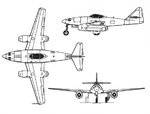I am not an expert in these things but I think the major tactic was just being there as an escort, this meant the 262s must keep their speed near the maximum which restricted them to high speed staffing passes, if they slowed down to make an easy kill they were sitting ducks themselves.
Right...the 262 would or should employ its speed in a single pass at an enemy fighter and never try to turn with one. The Me-262 was an interceptor of bombers, not a jet "fighter."

